Haswell and GK110 vs. Ivy and GK104: DigitalStorm Virtue System Review
by Dustin Sklavos on June 23, 2013 12:00 PM ESTSystem and Gaming Performance
The two subjects we want to examine with the DigitalStorm Virtue and its 4.4GHz Intel Core i7-4770K are whether or not the overclocking plateau really has stayed level over the past two or three generations of Intel CPUs, and just how close GK104 can really get to GK110. Remember that the GeForce GTX 770 actually ships with memory clocks higher than most GTX 680s could attain, and memory bandwidth was frequently the bottleneck with GK104.
An important comparison to keep in mind: the 4.6GHz Intel Core i7-3770K is only clocked about 5% faster than the new 4.4GHz i7-4770K. Haswell tends to be roughly 10% faster clock per clock than Ivy, so with some dirty math it would take about a 4.8GHz i7-3770K to make up the performance gap.
As for the overclocked GTX 680 against the GTX 780, that's a bit trickier. The 780 is working with almost 50% more memory bandwidth, and with some extremely dirty math, about 20% more shader power. That's before you try to calculate the GTX 780's boost clocks, which are much jumpier than the GTX 680's. Even missing an entire SMX cluster, GK110 is still a bear compared to the more svelte GK104.
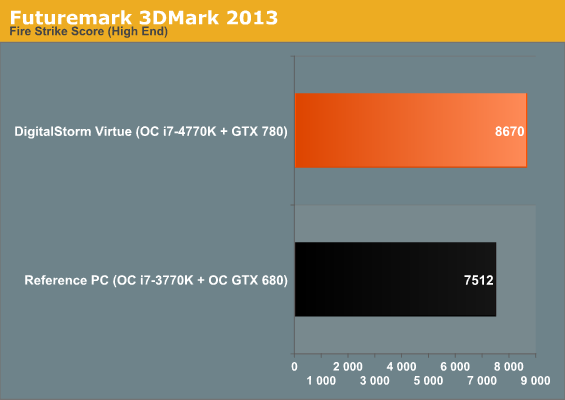
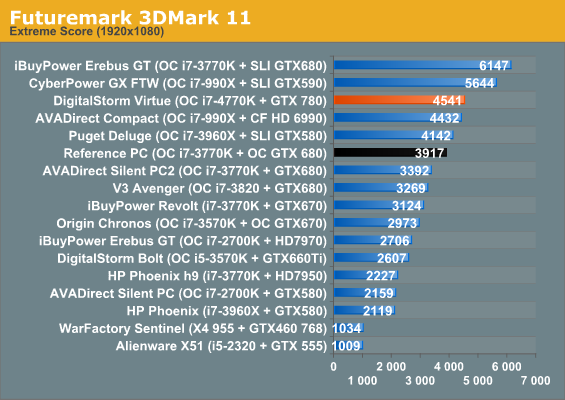
The 3DMarks pretty much tell the story. In both 3DMarks, a stock 780 is still ~15% faster than a heavily overclocked GTX 680.
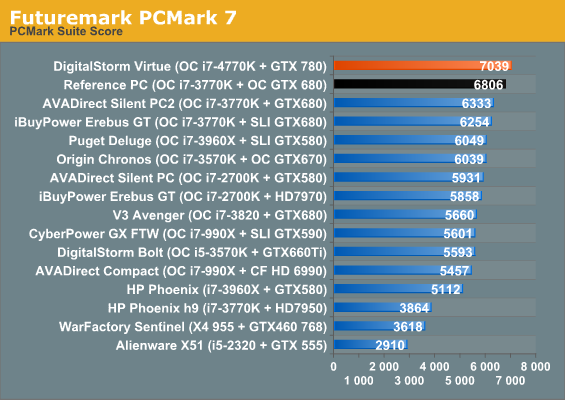
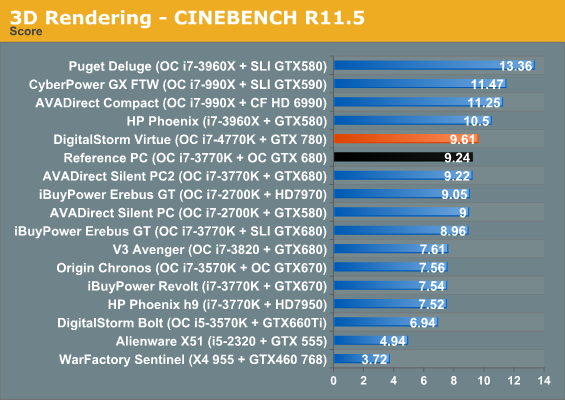
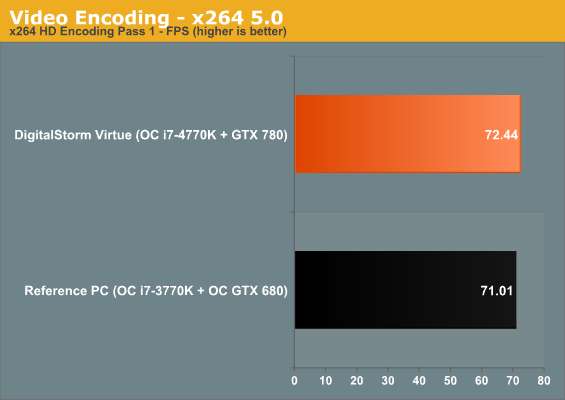
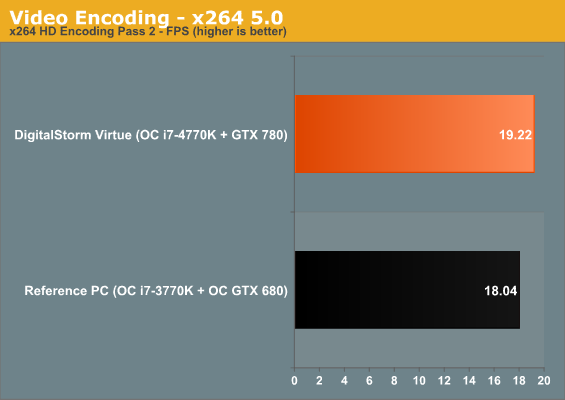
While PCMark7 tends to simply favor newer, faster SSDs, the difference between Haswell and Ivy gets a lot uglier when we isolate CPU performance. Consensus is that we've lost a bit of overclocking headroom with Haswell, making the comparison between a 4.6GHz Ivy and 4.4GHz Haswell a reasonably fair one. Cinebench is just 5% faster on Haswell, the first pass of the x264 benchmark is a dismal 2% faster on Haswell, and the second pass is at least a slightly healthier 7%.
Also note the improvement from Sandy to Ivy in Cinebench, though: our fastest Ivy is just 2% faster than our fastest Sandy. That Sandy was also running at 4.6GHz. Ivy at least brought a fat reduction in power consumption and TDP from Sandy despite the mediocre IPC improvement, but Haswell actually increased power consumption.
The math gets even uglier when we compare Sandy to Haswell. A 4.4GHz i7-4770K is only 6% faster than a 4.6GHz i7-2700K. That means that in two subsequent generations, the performance ceiling has barely moved. Anand is keen to point out that Intel's ability to eke out ~10% additional IPC on the same 22nm process node with a new architecture is impressive, and that may be true from a technical perspective, but Intel has offered enthusiasts virtually nothing new for two generations running. So whether or not the technical achievement is notable, end users are still left holding the bag. At this point, if you're hankering for more performance on the CPU, your best bet is actually to either go for an i7-3930K or wait for Ivy Bridge-E and hope Intel doesn't bone us with thermal paste instead of fluxless solder again. The only real selling point of Haswell, as far as I'm concerned, is access to the Z87 chipset.
Thankfully, while the jump in price from the NVIDIA GeForce GTX 680 to the GTX 780 isn't a particularly happy one, at least that dial moved pretty substantially. We tested every game at our Enthusiast settings (essentially maxed out and topping out at 4xMSAA), at 1920x1080 and then at 5760x1080.
|
GTX 680 1080p |
GTX 780 1080p |
% Perf. Increase |
GTX 680 Surround |
GTX 780 Surround |
% Perf. Increase |
|
| BioShock Infinite | 83.1 | 91.6 | 10.2% | 32.5 | 37.1 | 14.2% |
| Elder Scrolls V: Skyrim | 93.4 | 104.1 | 11.5% | 72.1 | 75.7 | 5% |
| GRID 2 | 87.3 | 109.2 | 25.1% | 39.4 | 49.2 | 24.9% |
| Metro: Last Light | 36.7 | 40.7 | 10.9% | 13.7 | 15.7 | 14.6% |
| Sleeping Dogs | 90 | 101.2 | 12.4% | |||
| StarCraft II: Heart of the Swarm | 73.5 | 86.2 | 17.3% | |||
| Tomb Raider | 64.3 | 72.5 | 12.8% | 31.8 | 36.5 | 14.8% |
So how do we interpret these results? First, excluding the outlying Skyrim surround results, even a diehard overclocked GTX 680 user can expect to net at least 10% more power from the GTX 780. Bumping up to 5760x1080 actually even lets the GTX 780 start to stretch its legs; while the 680 seems to be limited either by memory capacity or memory bandwidth, the 780's 384-bit memory bus and extra 1GB of GDDR5 do a solid job of picking up the slack.
Remember, too, that this is all before you overclock the 780. The consensus right now seems to be that the 780 has a very healthy amount of overclocking headroom, more than the 680 did, so if you're willing to sacrifice some power consumption and noise, you can theoretically push the 780 to Titan levels and even a bit beyond. At that point, it will pull away substantially from the 680 and by extension, the 770. I'm planning to do a custom liquid cooling review in the near future to get a grasp of just how far we can reasonably push a pair of GTX 780s, and given that I regularly see boost clocks of about 1GHz on them with just air cooling and no overclocking, I'm pretty optimistic.










70 Comments
View All Comments
wumpus - Monday, June 24, 2013 - link
Airflow. 800W of airflow.[Actually this ends up being heat in the ambient room to, just not always in the case. No matter what work you do, adding 800W into a area means 800W of heat: EM waves just makes the area bigger :)].
iamezza - Monday, June 24, 2013 - link
Actually all the power consumed will eventually end up back as heat. It's how physics works.MrSpadge - Monday, June 24, 2013 - link
Ouch.. someone's about to enter the shame corner of our little physics class!jameskatt - Sunday, June 23, 2013 - link
We long ago hit the wall on how fast on overclocked CPU can perform without burning out or using liquid cooling systems - the soaking the entire computer in mineral oil. It is simply the laws of physics that present a wall that CPUs cannot bridge.It is not surprising that Haswell hit that wall.
You can give GPUs more bandwidth and more cores to get faster and faster speeds. They key is that GPUs have massive numbers of cores and GPUs are used for massively parallel tasks.
The key to future performance is parallelism - the more cores in a CPU the better.
In day to day use, I have more than 20 apps running at the same time - at least I would like to. But I am limited by the number of cores my computer has. Four cores is simply not enough.
For example, Parallels and Jabber Video each require 1.5 cores each. When I have them on simultaneously everything else grinds to a halt since every other app has only one core left for it.
It would be nice to have 12 cores per CPU when doing a lot of multitasking.
The future is multiple cores - more than 4. The more cores the better.
It doesn't do good to complain about the limits of 4 core CPUs. They simply cannot do any better without specialized liquid cooling or other weirdness.
lmcd - Sunday, June 23, 2013 - link
You've clearly missed the complaint, which is that the die package used to be connected with what's called here a "fluxless solder," which has high thermal conductivity and transfers heat well to the metal surface that you see on production chips (I forget the name for that layer). That metal surface is then cooled with your heatsink, etc.The problem is that the fluxless solder was replaced with a thermal paste to save an incremental amount of money. The thermal paste is unable to transfer the same amount of heat per time. This means that no matter how good your cooler is, even if you're dissipating heat very quickly from the surface I mentioned, there is more heat retained inside the chip between the surface and the package.
So it's a valid complaint. And Haswell didn't hit a wall, its solder hit a price wall.
Nottheface - Monday, June 24, 2013 - link
So by what you have said above anyone who takes off the IHS and removes the "bad" paste should have great overclocking ability compared to leaving on the IHS with the paste. This is not true and means that isn't truly the base problem. Like Ivy Bridge delidding reduces the temperature of the chip greatly ~30°C, but only marginally increases overclocking.It has also been shown with Ivy Bridge that it isn't the paste so much as the spacing between the chip and the IHS that causes the bad heat transfer. The paste doesn't help, but for better heat transfer you are always better off removing extra interfaces and distance the heat has to travel.
MrSpadge - Monday, June 24, 2013 - link
I've heard that the 22 nm transistors couldn't take the temperatures the soldering produces. No hard proof, though.lmcd - Sunday, June 23, 2013 - link
Furthermore your "parallelism" is too all-powerful. If those wonderful GPU "cores" (hint, they're not cores; they're clusters) were given the same cooling mechanisms as these CPU cores, your computer would be up in flames or your magic "parallelism" would be running at 1/2 speed.Yes, multithreaded applications are great. Yes, more cores is great. But cooling the existing cores properly and running them at the frequencies they *should* be able to hit is still a valid solution, and in most applications there is the headroom to do so, should that fluxless solder be reintroduced into Intel's CPU packages.
And besides, if you're running parallels and jabber video, get yourself a Sandy-E. You're a niche, so buy the niche product that fits your needs. My 3960X meets my multicore needs, and you can even settle for a 3930K if you're not concerned about clockspeed.
wumpus - Monday, June 24, 2013 - link
The reason GPUs aren't on fire isn't so much superior cooling (you try cramming a CPU heatsink into a single or even double slot), so much as cores designed for high efficiency at the cost of painful latency. Trying to use one of those "cores" would be like going back to the PC-AT days (with the exception of floating point single performance, more like the DSPs of those days). Larrabee was a bit more CPUish (and thus would have melted down if they ever got performance anywhere near competitive) but would still be outperformed at traditional CPU (serial) tasks by an atom.Sabresiberian - Sunday, June 23, 2013 - link
The future is multiple cores, I think we are just beginning there, but you are wrong about the clock limit, and certainly AMD has proven that by releasing 5GHz factory CPUs. And, if the chips can be OC'd in extreme builds to 8GHz or better, then I suggest it IS feasible to eventually get that kind of clock in a production chip.If Intel wanted to, they could make production CPUs run at 5GHz base with a turbo to 5.8 easily enough. We could be OCing those to the 6GHz range. On air, or an AIO water cooler, no liquid nitrogen required. They just aren't putting their efforts in that direction.
3.6GHz is conservative.